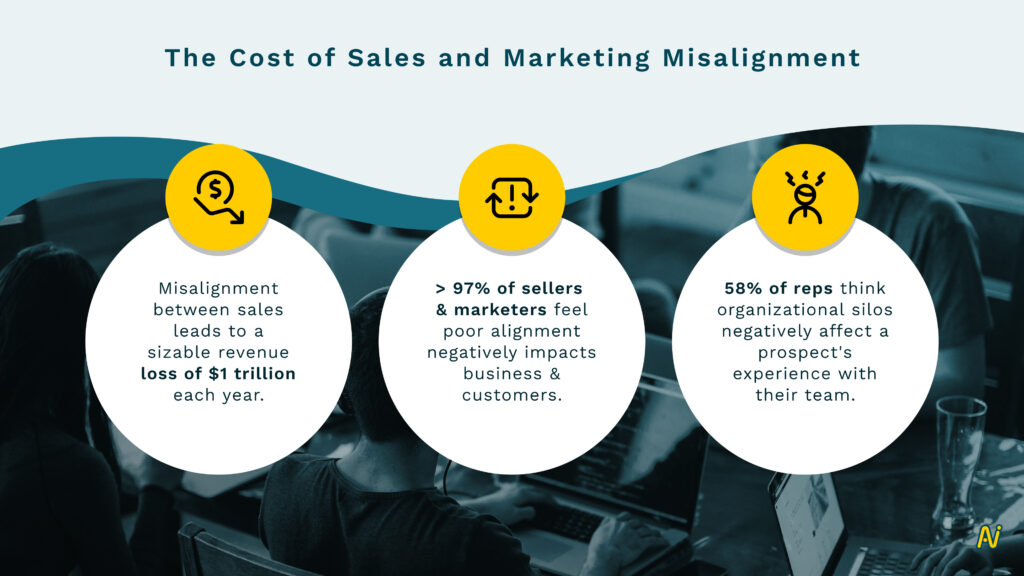
How to Drive Sales and Marketing Alignment With Unified Data
Sales and marketing alignment is crucial for revenue growth. Learn how unified data can help achieve cross-functional success.
Sales and marketing alignment is a huge ongoing problem. 9 in 10 sales and marketing professionals say they’re misaligned. That’s worrying, particularly in a fast-moving business environment.
Since sales and marketing performances are measured differently, both teams use different approaches and systems, create disjointed content, maintain a passive relationship, and set disconnected goals. All of this leads to revenue leakage.
So, how can you solve the sales and marketing alignment problem and drive revenue? Let’s find out.
What is Sales and Marketing Alignment?
Sales and marketing alignment is a series of steps or processes that each team undertakes to ensure seamless collaboration. It covers the length and breadth of revenue-generating activities to improve business performance.
Sales and marketing alignment is critical in a rapidly growing digital world, where teams are scattered across continents and working remotely. Alignment isn’t an outcome but rather a continuing joint effort. More than 97% of sellers and marketers feel poor alignment negatively impacts business and customers.

Most commonly, misalignment between sales and marketing arises when:
- Marketing hands off leads generated to sales without complete or updated contact information.
- Both teams set disconnected revenue goals based on their strategies.
- Communication between sales and marketing is muddled.
Cross-functional collaboration smooths these bumps out for more effective GTM alignment, performance management, productivity, and growth. The first step to setting the wheels of alignment in motion is incorporating unified data into the process.
A Peek into Unified Data
With 2.5 quintillion bytes of data generated every day, it’s safe to say businesses are no strangers to the power of data. But creating value from it is a whole different ball game. Nearly 50% of employees find it difficult to share information seamlessly between teams owing to poorly integrated systems.
The result — incomplete, inaccurate, non-compliant, outdated, and inconsistent dirty data. This doesn’t just affect reps’ performance but also customer experience. As much as 58% of reps think organizational silos negatively affect a prospect’s experience with their team.
What can save the day?
You’re right if you guessed Unified Data (we did give you a hint).
Unified data combines data from unalike sources and disintegrated systems into a single, central view. It gets everyone on the same page by capturing data from tools across the sales and marketing tech stack. It also leads to better customer engagement, reduced customer churn, and increased ARR.
In a recent report, Forrester highlighted that 56% of buyers communicate with sellers 5 times or more before closing the deal. And 62% buyers expect their sales rep to answer complex questions instantaneously, to shorten the sales cycle. And with as much as 52% of buyers doing their research, marketers need to up their game, too.
Their journey leaves behind data breadcrumbs that have valuable insights if looked at closely.
To make the most of buyer engagement, sales and marketing alignment must ensure continuous data exchange. New prospect information keeps coming in, which should be accumulated and managed so that all details are up-to-date and ready at their fingertips.
That’s the problem unified data solves.
Automation serves even better when the organization and datasets are large and coupled with AI for contextual insights.
Marketing data that sales can use includes:
- Lead and their organizational data
- Lead scoring and qualification results
- Customer behavior and intent analysis
On the other hand, sales data can help marketing:
- Connect campaign objectives and performance to revenue
- Nurture leads with relevant and engaging content
- Prepare lookalike models of sales-ready leads for new prospects
But why should you work on aligning both teams in the first place?
The Need for Sales and Marketing Alignment
For starters, misalignment between sales leads to a sizable revenue loss of $1 trillion each year.
Marketing and sales are both key parts of the organizational puzzle. Conventionally, they function separately in a world of their own, with different objectives, revenue goals, and processes. This creates undesirable friction and prevents teams from operating to their best potential.
But in today’s dynamic business environment, events such as pandemics and economic instability could change the game drastically. A disconnected sales and marketing relationship is no longer viable for business growth.
Moreover, the buying process is becoming more complex. Businesses need to build these relationships on trust and personal relationships. And buyers are now buying groups — key stakeholders from various departments. As a result, the buying group wants to speak with multiple people at the service provider’s end to evaluate their company, processes, and offerings as a whole.
As the buying process evolves, so does the customer journey. This journey ended at deal closure in a traditional sales funnel.
In the modern sales funnel, following a bow-tie approach, the customer journey continues with onboarding, creating impact, and sustaining growth. Specifically for businesses that rely on subscriptions for their bread and butter, post-sales service and retention are equally, if not more important than closing a deal.
Moving in that direction, most SaaS businesses (81% of them) place customer retention high on their priority list on a scale of 1 to 10. And rightly so because 90% of happy customers are likely to purchase again, and as much as 93% will become repeat customers for companies with good post-sale support.
But buyers seem to need sales less and less.
66% of buyers prefer a rep-free purchase experience. Selling is now more remote than ever, but virtual sales execution is still falling short of expectations. Compared to the expected front-line win rate of 62%, the achieved win rate is only 45%. Sales and marketing alignment can help solve the problem. But it needs to be more than an exchange of information; it needs to be an exchange of ideas.
What sales and marketing alignment should look like:

Best Practices for Sales and Marketing Alignment with Unified Data
Organizations with well-aligned sales and marketing functions see 36% higher customer retention rates and 38% higher sales win rates.
Additionally, a cross-functional collaboration between teams can increase key customer spend by up to 215%!
There couldn’t be a better case for sales and marketing alignment. And you can achieve it, too. Here’s how.
1. Define shared goals and strategies
The first step in setting up sales and marketing alignment is defining team goals. Establish a common ground through shared Objectives and Key Results (OKRs). For example, sales and marketing must increase revenue by 15% at the end of Q1.
But improving alignment isn’t as easy as setting common goals. Leaders need to identify processes that could potentially cause friction. Like it happens during leads handoff, MQL and SQL definitions could confuse the teams and result in a poor customer experience.
If needed, train your sales and marketing teams together to familiarize them with the other’s processes, responsibilities, and tasks. When sales reps understand what marketing does and vice versa, they can smoothen the lead nurturing and handoff process to a large extent.
Lastly, while defining goals, you can also set up unified processes for lead scoring, lead generation, and customer support.
2. Treat the customer journey as an integrated process
To do this, you need to set up an Ideal Customer Profile (ICP) and define what a lead is for marketing and sales.
You may have heard of ICP or, even better, set one up for your sales and marketing teams. However, the buying environment is evolving. While organizations previously defined ICP for individuals, today, they need to lay it down for buying groups and key stakeholders.
Another change in the buying environment is that it’s not linear anymore. When defining MQL and SQL, the shared objective must be to convert prospects to customers and retain them. But sales and marketing need to be more flexible than ever before.
In fact, it may be time to do away with separate definitions for MQL and SQL. In the Smarter Marketer podcast, Dean Mannix states that these different terms may lead to siloed processes. On the other hand, if both were to work towards a common ICP, their tasks and activities could be more fluid and flexible, leading to better sales and marketing alignment.
3. Consider the buying group
Conventionally, the buyer was an individual. In the modern business environment, 80% of B2B buying decisions have 3+ members in the buyer group. Sales and marketing alignment should gear towards consolidated efforts for the buyer — a group rather than an individual.
Once the teams have defined the ICP and target market, the marketing team seeks out active buying groups. It further engages the group as a whole and key stakeholders through relevant content for each.
Take this as an example. A buying group has a stakeholder from the IT department and another from finance. To the IT stakeholder, marketing sends technical information to educate them about the solution. With the finance stakeholder, marketing engages in ROI-led conversations. For the group, marketing creates value by showcasing how the solution caters to each pain point.
Sales and marketing will then qualify and prioritize buying groups with higher intent to purchase. Sales then takes over, validating buyer needs, accelerating pipeline opportunities, aligning solutions to the needs, and pushing deals to successful closure.
4. Refer to a single source of truth
This is where it all comes together with unified data. A unified CRM provides a more comprehensive and accurate picture of the customer journey. With data in hand, sales and marketing leaders can make more informed decisions.
Sales will know a prospect’s progress through the pipeline. Reps will know how a lead found their product and what content they engaged with during their journey. They can also dig into multiple selling opportunities for each account with complete information on key stakeholders.
On the other hand, marketing can gather deeper insights into the buyer’s needs to create highly relevant and valuable content. It can incorporate these insights into ICP and continuously refine segmentation and lead nurturing.
Unified data also helps with revenue attribution. Sales and marketing can track, analyze and measure a lead’s touchpoints. They can figure out which touchpoint should a deal closure be attributed to — for example, quality ads, demos, sales meets, or webinars.
5. Coordinate Account Based Marketing (ABM) campaigns
With sales and marketing alignment, you can improve content creation for the customer journey. This ensures that the information on all your channels is in line with sales-buyer interactions.
Marketing teams can incorporate inputs from the seller’s conversation with the buyer. And use important points to shape their messaging. Marketing can also audit existing sales content and create or refresh content wherever needed.
When marketing and sales know all the talking points, marketing can also help sales leaders and reps showcase their expertise on online channels. The team can create content templates for sales reps to post, capturing prospects’ attention.
6. Combine workflows and communication
Regarding workflows and communication, sales and marketing alignment can work in two ways — external and internal.
Externally, it’s best to follow a marketing-first approach. Your prospects may not have heard of your brand. But through consistent campaigns and branding, marketing builds your presence in the buyer market. If buyers know that you can provide value, they are more likely to convert from prospects to customers.
Internally, it’s important to keep both teams involved. Marketing reps can shadow sales calls, attend sales briefs and have regular brainstorming sessions with the sales team for a deeper understanding of the buyer. Leaders should ensure that cross-functional collaboration and communication are as smooth as possible.
7. Measure performance with common KPIs
When it comes to sales and marketing alignment, it’s best to have common KPIs to measure performance against.
Sales KPIs are generally win rate, deal closure rate, contracts renewed, and new prospects. On the other hand, marketing KPIs could be brand awareness, campaign success, and lead quality plus quantity.
Instead, set the same KPI — revenue generation with pipeline management and optimized sales-marketing process. It’s possible to track and monitor this KPI when you have a single source of truth or unified data in place.
In addition to the above, you can connect individual stakeholders to their buying groups, monitor relevant opportunities within the group, and track their progress through the pipeline and revenue cycle.
8. Invest in tools that boost alignment
A unified revenue data capture solution like Nektar will consistently help you create value and close more deals. Even if sales and marketing teams use different systems, Nektar combines data from across channels for a 360-degree view.
You’ll gain valuable insight for faster and better deal closure from each interaction with the buying group, be it over social media, email, or even calls. Moreover, sales and marketing alignment gets easier with intent data, enriched data, and conversation insights.
Lastly, automation will make alignment simpler and faster.
Alignment = Value = Driving Sales
There’s no doubt. Sales and marketing alignment can drive value, thereby improving lead quality and chances of conversion. As much as 84% of the best-in-class organizations empower marketing and sales with aligned access to CRM.
When sales and marketing operate with unified data, marketing can educate the customer better, nurturing the most sales-friendly ones. Sales maintains consistency in communication, effectively targeting buyer needs with better precision and converting them.
Nektar enables unified data capture with an automated intelligent layer over your CRM to align sales and marketing. It captures valuable contact data across buying groups and tools, even if both teams have different tech stacks.
The better the customer fit, the lower the churn, too. Higher engaged buyers lead to better pipeline management and, thus, better ROI.
Don’t let sales and marketing alignment be a one-off activity. Talk to our team and find out how to ensure consistency for sales success.
PUBLISHED BY







